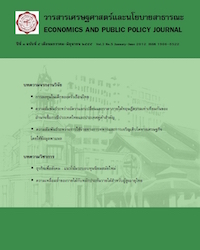ความสัมพันธ์ระหว่างอัตราแลกเปลี่ยนและราคาภายใต้ทฤษฎีความเท่าเทียมกันของอำนาจซื้อ: กรณีประเทศไทยและประเทศคู่ค้าที่สำคัญ
Main Article Content
บทคัดย่อ
การศึกษานี้มีวัตถุประสงค์เพื่อศึกษาความสัมพันธ์ระหว่างอัตราแลกเปลี่ยนและระดับราคาสินค้าในระยะยาวของประเทศไทยและประเทศคู่ค้าที่สำคัญ โดยใช้ข้อมูลทุติยภูมิรายไตรมาส จาก ค.ศ. 1984 – 2011 และทดสอบความสัมพันธ์เชิงดุลยภาพในระยะยาวของอัตราแลกเปลี่ยนและราคาตามวิธี Cointegration รวมทั้งศึกษาความสัมพันธ์เชิงเหตุและผลของอัตราแลกเปลี่ยนและราคาด้วยวิธี Causality ผลการศึกษาพบว่า 1) แนวคิดทฤษฎีความเท่าเทียมกันของอำนาจซื้อ คือ ระดับราคาสินค้าโดยเปรียบเทียบของสองประเทศเป็นตัวกำหนดการเปลี่ยนแปลงของอัตราแลกเปลี่ยนในระยะยาว 2) ธุรกรรมการแลกเปลี่ยนเงินตราต่างประเทศมีการขยายตัวกว่า 2 เท่าตัวในระยะ 10 ปีที่ผ่านมา และ SWAP เป็นธุรกรรมที่ได้รับความนิยมสูงสุดคิดเป็น ร้อยละ 45 ของธุรกรรมทั้งหมด นอกจากนี้ดอลลาร์สหรัฐเป็นสกุลเงินที่ได้รับความนิยมสูงสุดในการทำธุรกรรมระหว่างประเทศ 3) การศึกษาความสัมพันธ์เชิงดุลยภาพระยะยาวของอัตราแลกเปลี่ยนและราคาตามวิธี Cointegration พบว่าประเทศที่มีความสัมพันธ์เชิงดุลยภาพระยะยาว ณ ระดับนัยสำคัญ 5% มีเพียง 4 ประเทศ ได้แก่ ออสเตรเลีย นิวซีแลนด์ อินโดนีเซีย และญี่ปุ่น ส่วนความสัมพันธ์เชิงเหตุและผลของอัตราแลกเปลี่ยนและราคาตามวิธี Causality พบว่าผลการศึกษาสนับสนุนทฤษฎีฯได้เพียงบางส่วน เช่น ออสเตรเลีย นิวซีแลนด์ ฟิลิปปินส์ และสาธารณรัฐเกาหลี ที่ระดับราคาในประเทศ หรือ ระดับราคาต่างประเทศมีอิทธิพลต่อการเปลี่ยนแปลงอัตราแลกเปลี่ยน
The Relationship between Exchange Rates and Prices under The Purchasing Power Parity: A Study of Thailand and Major Trade Partners
The main purpose of study aims to analyze the relationship between exchange rate and prices under the PPP hypothesis in the case of Thailand and its major trading countries during 1984-Q1 through 2011-Q4. A Vector Autoregressive (VAR) model with the applications of cointegration and causality test are also employed. The results reveal as follows: i) The Purchasing Power Parity (PPP) hypothesis indicates that the relative prices in two countries have influence on exchange. ii) The world foreign exchange rate activities have 2 time increase during this 10 years whereas SWAP is the most popular. It has 45% stake of the total activity. In addition, U.S. dollar is the most active for international transaction. iii) The only four countries including Australia, New Zealand, Indonesia and Japan have the existence of a long run relationship between exchange rate, domestic and foreign prices at 5% level of significance. For causality results, they have only partial support the validity of PPP which domestic price or foreign price has impact on exchange rate in the case of Australia, New Zealand, Philippine and South Korea.
Article Details
สงวนลิขสิทธิ์ © 2553 คณะเศรษฐศาสตร์ มหาวิทยาลัยศรีนครินทรวิโรฒ
คณะเศรษฐศาสตร์ มหาวิทยาลัยศรีนครินทรวิโรฒ จัดพิมพ์วารสารเศรษฐศาสตร์และนโยบายสาธารณะ เพื่อเผยแพร่บทความวิชาการทางเศรษฐศาสตร์ นโยบายสารธารณะ และสาขาอื่นๆที่เกี่ยวข้อง ทัศนะและข้อคิดเห็นใดๆ ที่ปรากฏในวารสารเป็นความคิดเห็นส่วนตัวของผู้เขียน โดยบทความที่ได้รับการตอบรับจะถือเป็นลิขสิทธิ์ของคณะเศรษฐศาสตร์ มหาวิทยาลัยศรีนครินทรวิโรฒ
บรรณาธิการ อาจารย์ ดร.พลพัธน์ โคตรจรัส


